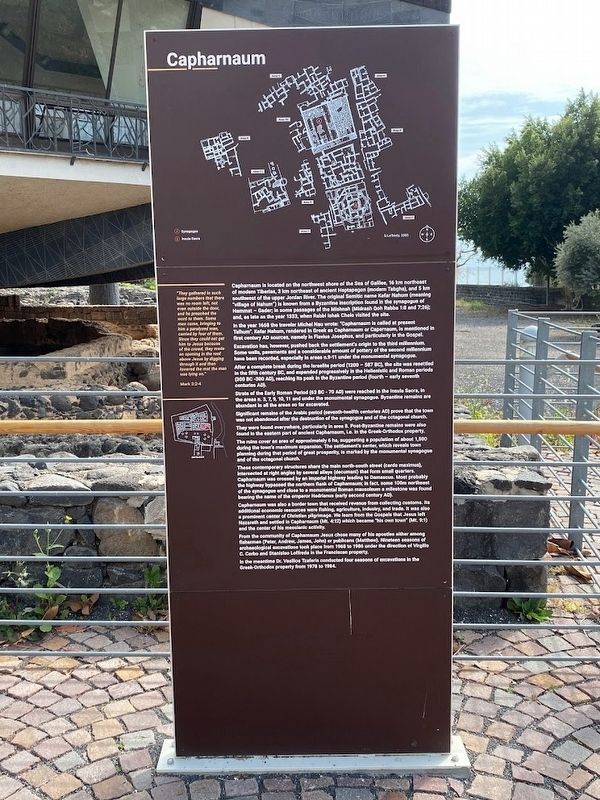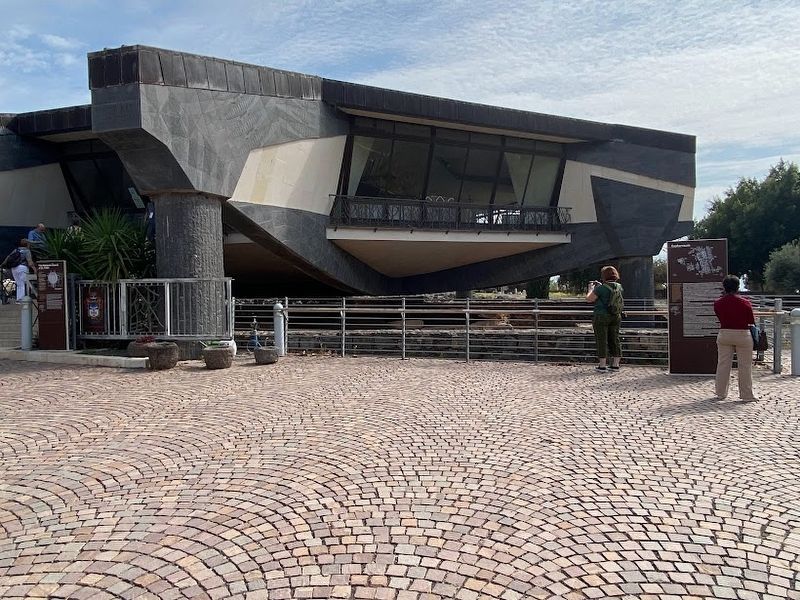Capernaum in Kinneret, Northern District, Israel — West Asia (the Levant in the Middle East)
Capharnaum
In the year 1668 the traveler Michel Nau wrote: "Capharnaum is called at present Talhum." Kefar Nahum, rendered in Greek as Capharnaum or Capernaum, is mentioned in first century AD sources, namely in Flavius Josephus, and particularly in the Gospels.
Excavation has, however, pushed back the settlement's origins to the third millennium. Some walls, pavements and a considerable amount of pottery of the second millennium have been recorded, especially in areas n. 9-11 and under the monumental synagogue.
After a complete break during the Israelite period (1200-587 BC), the site was resettled in the 5th century BC, and expanded progressively in the Hellenistic and Roman periods (300 BC-300 AD), reaching its peak in the Byzantine period (fourth-early seventh centuries AD).
Strata of the Early Roman Period (63 BC-70 AD) were reached in the Insula Sacra, in the areas n. 3, 7, 9, 10, 11 and under the monumental synagogue. Byzantine remains are abundant in all the areas so far excavated.
Significant remains of the Arabic period (seventh-twelfth centuries AD) prove that the town was not abandoned after the destruction of the synagogue and of the octagonal church.
They were found everywhere, particularly in area 8. Post-Byzantine remains were also found in the eastern part of ancient Capharnaum, i.e. in the Greek-Orthodox property.
The ruins cover an area of approximately 6 ha. suggesting a population of about 1,500 during the town's maximum expansion. The settlement's center, which reveals town planning during that period of great prosperity, is marked by the monumental synagogue and of the octagonal church.
These contemporary structures share the main north-south street (cardo maximus), intersected at right angles by several alleys (decumani) that form small quarters. Capharnaum was crossed by an imperial highway leading to Damascus. Most probably the highway bypassed the northern flank of Capharnaum; in fact some 100 meters northeast of the synagogue and close to a monumental Roman mausoleum a milestone was found bearing the name of the emperor Hadrianus (early second century AD).
Capharnaum was also a border town that received revenue from collecting customs. Its additional economic resources were fishing, agriculture, industry, and trade. It was also a prominent center of Christian pilgrimage. We learn from the gospels that Jesus left Nazareth and settled in Capharnaum (Matthew 4:12) which became "his own town" (Matthew 9:1) and the center of his messianic activity.
From the community of Capharnaum Jesus chose many of his apostles either among fishermen (Peter, Andrew, James, John) or publicans (Matthew). Nineteen seasons of archaeological excavations took place from 1968 to 1986 under the direction of Virgilio C. Corbo and Stanislao Loffreda in the Franciscan property.
In the meantime Dr. Vasilios Tzaferis conducted four seasons of excavations in the Greek-Orthodox propertyfrom 1978 to 1984.
"They gathered in such large numbers that there was no room left, not even outside the door, and he preached the word to them. Seme men came, bringing to him a paralyzed man Since they could not get Alto Jesus because of the creed, they made an opening in the roof above Jesum by dipping through it and then camed by four of them lowered the mat the man was lying on Mark 22-4
Topics. This historical marker is listed in these topic lists: Anthropology & Archaeology • Churches & Religion • Roads & Vehicles • Settlements & Settlers.
Location. 32° 52.826′ N, 35° 34.516′ E. Marker is in Capernaum, Northern District, in Kinneret. Marker can be reached from Northern District Route 87. Touch for map. Touch for directions.
Other nearby markers. At least 8 other markers are within walking distance of this marker. The Memorial Church of St. Peter (here, next to this marker); a different marker also named Capharnaum (a few steps from this marker); The House of Peter (a few steps from this marker); The Synagogue of Capharnaum (within shouting distance of this marker); Excavations in Capharnaum (within shouting distance of this marker); Sea of Galilee (within shouting distance of this marker); The Synagogue of Jesus (within shouting distance of this marker); a different marker also named Capharnaum (about 90 meters away, measured in a direct line). Touch for a list and map of all markers in Capernaum.
Credits. This page was last revised on April 27, 2023. It was originally submitted on April 26, 2023, by Darren Jefferson Clay of Duluth, Georgia. This page has been viewed 44 times since then and 5 times this year. Photos: 1, 2. submitted on April 26, 2023, by Darren Jefferson Clay of Duluth, Georgia. • Andrew Ruppenstein was the editor who published this page.

